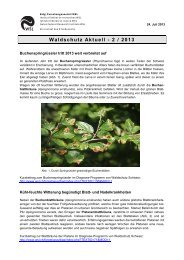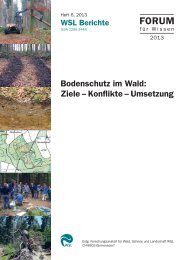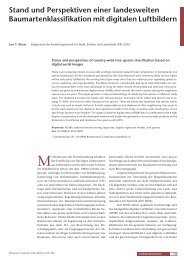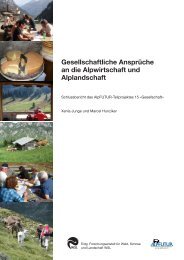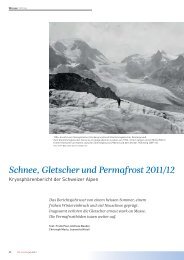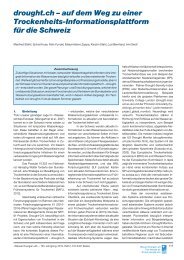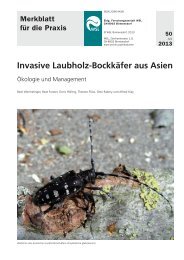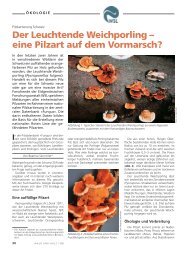Ecology and management of the spruce bark beetle Ips ... - WSL
Ecology and management of the spruce bark beetle Ips ... - WSL
Ecology and management of the spruce bark beetle Ips ... - WSL
You also want an ePaper? Increase the reach of your titles
YUMPU automatically turns print PDFs into web optimized ePapers that Google loves.
70<br />
4. Flight activity<br />
Diurnal flight activity is from approximately 9 a.m.<br />
to 9 p.m., with maximum at noontime <strong>and</strong> in <strong>the</strong> early<br />
afternoon (Funke <strong>and</strong> Petershagen, 1991). Obviously,<br />
this depends on <strong>the</strong> temperature—minimum air temperature<br />
for flight was 16.5 8C, <strong>and</strong> optimum temperature<br />
between 22 8C <strong>and</strong> 26 8C (Funke <strong>and</strong><br />
Petershagen, 1994; Lobinger, 1994). This may be<br />
important for optimizing water use in sprinkled log<br />
storage systems. Swarming depended greatly on sunshine.<br />
Even with short sunbursts, more I. typographus<br />
<strong>beetle</strong>s took flight than during periods without sunshine<br />
(Lobinger <strong>and</strong> Skatulla, 1996). Flight activity<br />
had an upper threshold <strong>of</strong> 30 8C (Lobinger, 1994).<br />
Males emerged earlier than females (Zuber <strong>and</strong> Benz,<br />
1992). This makes sense since pioneer males have to<br />
find <strong>and</strong> colonize susceptible trees <strong>and</strong> excavate <strong>the</strong><br />
nuptial chambers before females can reproduce.<br />
Studies in <strong>the</strong> Bavarian Forest have confirmed that,<br />
for a successful attack on living trees in spring, at least<br />
three to four warm days in a row are needed with<br />
temperatures well above <strong>the</strong> swarming threshold<br />
(Weissbacher, 1999). O<strong>the</strong>rwise <strong>the</strong> frittered flight<br />
lowers <strong>the</strong> chance <strong>of</strong> successfully overcoming <strong>the</strong><br />
defense mechanisms <strong>of</strong> a living tree (see Section 8.1).<br />
5. Pheromone biology<br />
It is known that <strong>the</strong> aggregation pheromones <strong>of</strong> I.<br />
typographus consist <strong>of</strong> terpenoids that are biosyn<strong>the</strong>sized<br />
from tree resin components. These intraspecific<br />
semiochemicals are much more attractive than <strong>the</strong><br />
volatiles (kairomones) emitted by <strong>the</strong> <strong>spruce</strong> trees.<br />
Conspecific <strong>bark</strong> <strong>beetle</strong>s are attracted by aggregation<br />
pheromones when a suitable breeding substrate is<br />
available. However, <strong>the</strong>re is also evidence that I.<br />
typographus produces repellent pheromones where<br />
<strong>the</strong> substrate is unsuitable for breeding (Francke et<br />
al., 1995). Traps baited with both <strong>the</strong> commercial lure<br />
Pheroprax 1 <strong>and</strong> <strong>the</strong> anti-aggregation pheromone verbenone<br />
or <strong>the</strong> tree volatile (+)-alpha-pinene caught<br />
only 2–30% <strong>of</strong> <strong>the</strong> number <strong>of</strong> <strong>beetle</strong>s caught in traps<br />
baited exclusively with Pheroprax 1 (Niemeyer et al.,<br />
1995b; Reddemann <strong>and</strong> Schopf, 1996; Zhang et al.,<br />
1999). While <strong>the</strong> pinene component also prevented<br />
trees from being attacked, verbenone did not. The<br />
B. Wermelinger / Forest <strong>Ecology</strong> <strong>and</strong> Management 202 (2004) 67–82<br />
attractiveness <strong>of</strong> a vital <strong>spruce</strong> tree, which is low per<br />
se, was distinctly higher when a pheromone dispenser<br />
was attached (Franklin <strong>and</strong> Gregoire, 1999).<br />
Earlier work has already shown that <strong>the</strong> energy<br />
reserves <strong>of</strong> I. typographus <strong>beetle</strong>s need to be depleted<br />
before <strong>the</strong> <strong>beetle</strong>s will respond to pheromones (Gries,<br />
1985). Likewise, Nemec et al. (1993) found that<br />
<strong>beetle</strong>s not responding to pheromone had a higher<br />
body weight than those attracted to <strong>the</strong> lure. The<br />
<strong>beetle</strong>s attracted to <strong>the</strong> pheromone traps differed in<br />
glycogen (representing reserves) <strong>and</strong> protein (representing<br />
flight muscles) levels, 30% <strong>of</strong> <strong>the</strong>m had high<br />
glycogen <strong>and</strong> low protein levels <strong>and</strong> were hypo<strong>the</strong>sized<br />
to originate from local populations <strong>and</strong> 70%<br />
were assumed to be migrants (high protein levels).<br />
O<strong>the</strong>r primary scolytids have been found to produce<br />
aggregation pheromones only until <strong>the</strong> moment when<br />
<strong>the</strong> host resistance threshold was reached (expressed in<br />
attacks per unit area), i.e. as long as <strong>the</strong> host’s resin<br />
system remained active (Paine et al., 1997).<br />
6. Dispersal<br />
Dispersal is tightly connected to <strong>the</strong> response <strong>of</strong> <strong>the</strong><br />
<strong>beetle</strong>s to pheromones. Several authors have performed<br />
mark-recapture experiments to estimate <strong>the</strong><br />
dispersal <strong>and</strong> flying distance <strong>of</strong> <strong>bark</strong> <strong>beetle</strong>s after<br />
emergence. This involves marking <strong>the</strong> <strong>beetle</strong>s, releasing<br />
<strong>the</strong>m <strong>and</strong> recapturing <strong>the</strong>m in traps. Usually, only a<br />
small proportion <strong>of</strong> <strong>the</strong> released <strong>beetle</strong>s are recaptured.<br />
In Sweden, Weslien <strong>and</strong> Lindelöw (1990) caught 8%<br />
<strong>of</strong> <strong>the</strong> released <strong>beetle</strong>s in pheromone traps at a distance<br />
<strong>of</strong> 100 m, <strong>and</strong> 2% at 1200–1600 m. They employed<br />
pipe traps with <strong>Ips</strong>lure 1 , while in Central Europe slot<br />
traps with Pheroprax 1 are commonly used. Similar<br />
recapture rates at <strong>the</strong> above distances from <strong>the</strong> release<br />
point were reported by Zumr (1992) <strong>and</strong> Duelli et al.<br />
(1997). Re-emerged parental <strong>beetle</strong>s (seeking facilities<br />
to produce sister broods) seem to travel less far<br />
(Zolubas <strong>and</strong> Byers, 1995). From <strong>the</strong> recapture data<br />
several authors have calculated diffusion curves in <strong>the</strong><br />
form <strong>of</strong> power or exponential functions. Using such<br />
equations <strong>and</strong> based on an attraction radius <strong>of</strong> a<br />
pheromone trap <strong>of</strong> 17–34 m (Schlyter, 1992), a trap<br />
at 25 m distance from an infested tree would catch<br />
from 20% (Weslien <strong>and</strong> Lindelöw, 1990) to 54%<br />
(Duelli et al., 1997) <strong>of</strong> <strong>the</strong> local population. However,



